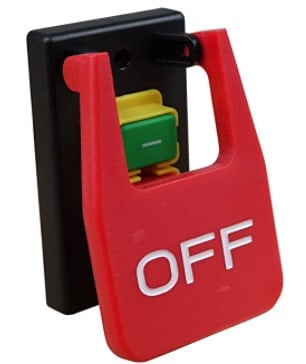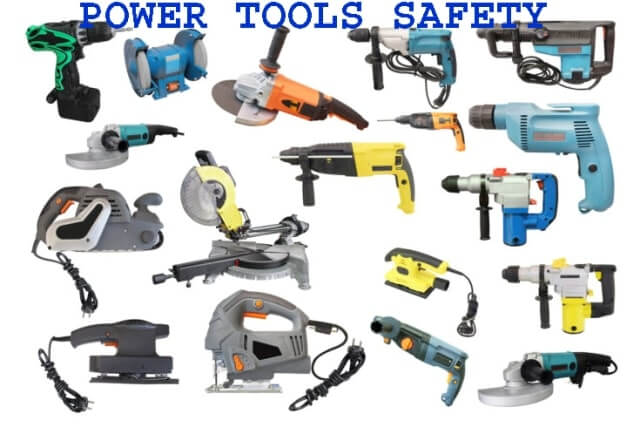Power tools safety is most important because these are more hazardous. Typically, injuries caused by power tools are burns, cuts, and strains. Other sources of injuries are electric shock, flying particles or flying objects in the eyes, fire, falls, the explosion of gases, and falling tools.
Tool injuries largely occur due to a lack of proper guarding. Many injuries happen because tools were modified, defective, or used improperly. Information and training must be provided to select the right tools for the right job. If a small hole is to be drilled and if it is easily possible by a hand drill, a power drill is not necessary. Hand tool hazards are less serious than the power tool hazard.
Table of Contents
General power tools safety tips:
- The power line should always be disconnected before accessories on a power tools are changed.
- After accessories changed on a power tool the guard should be replaced in correct adjustment before tool is used again.
- Dead man control must be used. Dead man control means the tool operates till the button is pressed and it stops as the button is released.
- A tool should not be left in an overhead place where there is a chance that the line if pulled, will cause tool to fall.
- Flexible cords, cables should be hung overhead and on safe point and not over nails, bolts, sharp edges, oils, hot surfaces and chemicals, etc.
- Cord cables should be frequently checked for cracks, opened joints, cut phases and earth wires.
- Tool supplier should be given complete information about the job for which a tool is required, so that he can recommended the most appropriate tool for that job.
- Periodic inspection is necessary to find defects because it prevents hazards and costly breakdowns.
- Defective tools should be tagged and replaced.
- Workers should be trained to inspects tools, identify defects, report and repair.
- Record of date of inspection, fault noticed and date of repair is necessary. Cause of fault and details of repair carried out can also be added to such records.
- For cleaning purpose non-flammable and non-toxic solvent should be used.
- While using electric drills saws and grinding wheels, eye protection is always required.
- Drill bit should not be excessive length, otherwise it may break.
- Electric saws should have guards.
- Circular saws should be equipped with a trigger switch that shuts off power when pressure is released.
- Grinding wheels should be properly mounted and guarded.
- Dust should be cleaned daily
- Low voltage equipment’s used in tanks and wet area.
- Check plugs and sockets are unbroken.
- Buy quality tools for industry and tools must fulfil osha’s guidelines.
- Always follow power tools manufacturer’s instructions.
- One common mistake is not dressing right for the job. Avoid loose clothes and accessories like ties, jewellery, etc while working with power tools.
- Always wear appropriate personal protective equipment’s (PPE) like safety goggles and dust masks, etc.
- Use right tools for right job.
- Make sure you are standing in stable surface and maintain good balance when operating power tools.
- Never carry pointed tools in your pocket, carry them in tool box.
- Always store power tolls in safe places.
- Secure work with clamps.
- Avoid accidental starting by ensuring the tool is turned off before it is plugged in.
- Always read safety manual before operating power tools.
- Use hearing protection if you will be using power tools for a long time.
- Never use power tools if you are sick, tired and under the influence of alcohol.
- Bright and shadow free light required when operating power tools.
- Never use power tool if it is damaged.
- Make sure cutters or blades are clean and these are securely in place.
- Never carry a tool by the cord or hose.
- Use spark resistant tools when working near a fuel source.
- Do not use excessive force to cut or drill through hard material.
- Never use extension cords as permanent using. Use it for temporary basis.
- Do not use power tools if you are not trained.
- Clothing should be free of oil, solvents or frayed edges to minimise fire hazards from sparks.
Electric power tools safety tips
Electric shock is the main hazard from electrically powered tools. Another type of injury is electric flash burn, a minor shock that may cause falls and shocks, resulting in death.
- Do not tamper on or off switch.
- Do not use electric power tools in wet condition. If you want to use then insert ground fault circuit interrupter (GFCI).
- Don’t expose electrical power tools to rain or wet condition.
- Avoid power tool operation where explosive vapour or gasses are available.
- Flexible cords or cables should be protected from misuse.
- Plug socket connection should be tight and safe. No bare conductors should be inserted in plug.
- Three pin industrial top and socket must be used.
- Metal casing should be effectively earthed.
- Power cutting switches should be within reach and near the apparatus.
- Regular maintenance to check earth core.
- Earth core of the flexible cable should be properly connected to the metal work.
- Before you plug in any power tool make sure the power is switched off.
- Tools are to be double insulated or grounded.
- Don’t use kinked, frayed or broken cords.
Pneumatic tools safety tips
Pneumatic powered tools or air-powered tools are less hazardous than electrical power tools but these tools are dangerous due to pressurized air, even at low pressures, compressed air can cause injury. Pneumatic power tools are powered by compressed air.
- Grinders and impact tools have air hoses (pipe) which pose tripping or stumbling hazard.
- Self-storing recoiling air hoses are safe.
- Speed regulator or governor is necessary to avoid over speeding the tool.
- Air should be filtered and cooled moisture or water should be removed from the tool.
- These tools include riveting guns and jack hammers.
- These tools are started and stopped by means of shut of valve.
- The major hazard in pneumatic power tools are vibration and noise.
- White finger or vasospastic is a disease due to vibration exposure.
- Vibration and jerks cause strain in the joints.
- Noise level near the tool should be measured and ear protection should be given to the operator, if necessary.
- Eye protection is required due to flying chips.
- Two chippers should work away from each other, back-to-back, to prevent cuts from flying chips. They should not point a pneumatic hammer at any one.
- Jack hammer handles should have rubber grips to reduce effects of vibration and fatigue.
- Never store a loaded air gun.
- The safe operating pressure stated by the manufacturer will not be exceeded.
Hydraulic power tools safety tips
- Hydraulic power tools hydraulic chain saws and compression device.
- A small leak can impose high oil pressure on finger.
- Proper pressure hose should be selected.
- Safety pins are provided to shear at pre-set pressure.
- Pins should be secured by retainers.
- Power quality shear pins improper design or use of sockets can cause sudden failure and result in flying missiles.
- Oil and lubricants shall be stored as per the manufacturer’s instruction.
Personal protective equipment (ppe) used for power tools safety:
- Wear safety shoes to reduce chance of injury, if tool falls or drop.
- While working at overhead places with power tools, the operator should wear a safety belt and use a good platform and support.
- Dust type respirators should be worn on buffing and grinding jobs which produce harmful dusts.
- Ear protection and safety goggles or face shields should be worn.
Power tool safety switch:

- Power tools safety switches are very easy to installation.
- Power tool safety switch provides you with a magnetic emergency stop feature, preventing you tools from powering up after an unexpected outage, blown breakers and other power interruption.
- Power tools safety switches are easy to use. Switches are made with a simple and straight forward designing featuring a large “green” recessed “ON” button safe guarding against accidental starts and a large “red” “OFF” switch for a quick shut down.
- Power tools safety switches is a safeguard for table saws, router table, drill presses and other electrical equipment.
- Turn off tools with your hip or knee.
When using power tools never engage the:
When using power tools never engage the trigger lock.

